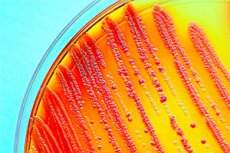New small molecule offers hope in fight against antibiotic resistance
最近審查:14.06.2024

Researchers at the University of Oxford have developed a new small molecule that can suppress the evolution of antibiotic resistance in bacteria and make resistant bacteria more susceptible to antibiotics. The research results were published in Chemical Science.
The global rise of antibiotic-resistant bacteria is one of the greatest threats to public health and development, as many common infections become increasingly difficult to treat. Drug-resistant bacteria are already expected to be directly responsible for about 1.27 million deaths worldwide each year and contribute to a further 4.95 million deaths. Without the rapid development of new antibiotics and antimicrobials, this figure will increase significantly.
New research led by scientists from the Ineos Oxford Institute for Antimicrobial Research (IOI) and the Department of Pharmacology at the University of Oxford offers hope for the discovery of a small molecule that works in combination with antibiotics to suppress the evolution of drug resistance in bacteria.
One of the ways bacteria become resistant to antibiotics is through new mutations in their genetic code. Some antibiotics (such as fluoroquinolones) work by damaging the DNA of bacteria, leading to cell death. However, this DNA damage can trigger a process known as the "SOS response" in the affected bacteria. The SOS response repairs damaged DNA in bacteria and increases the rate of genetic mutation, which can accelerate the development of antibiotic resistance. In a new study, Oxford scientists have identified a molecule that can suppress the SOS response, thereby increasing the effectiveness of antibiotics against these bacteria.
Researchers studied a series of molecules previously reported to increase the sensitivity of methicillin-resistant Staphylococcus aureus (MRSA) to antibiotics and prevent the SOS response of MRSA. MRSA is a type of bacteria that usually lives harmlessly on the skin. But if it gets inside the body, it can cause a serious infection that requires immediate treatment with antibiotics. MRSA is resistant to all beta-lactam antibiotics, such as penicillins and cephalosporins.
The researchers modified the structure of different parts of the molecule and tested their effect against MRSA in combination with ciprofloxacin, a fluoroquinolone antibiotic. This allowed the identification of the most potent SOS response inhibitor molecule, called OXF-077. When combined with various antibiotics from different classes, OXF-077 made them more effective in preventing the visible growth of MRSA bacteria.
In a key finding, the team then tested the susceptibility of bacteria treated with ciprofloxacin for several days to determine how quickly resistance to the antibiotic develops with or without OXF-077. They found that the emergence of ciprofloxacin resistance was significantly suppressed in bacteria treated with OXF-077 compared to those not treated with OXF-077. This is the first study to demonstrate that an SOS response inhibitor can suppress the evolution of antibiotic resistance in bacteria. Moreover, when treating previously ciprofloxacin-resistant bacteria, OXF-077 restored their sensitivity to the antibiotic to the level of bacteria that had not developed resistance.
These results suggest that OXF-077 is a useful tool molecule for further studying the effects of SOS response inhibition in bacteria and for the treatment of antibiotic-resistant infections. Further research is needed to test the suitability of these molecules for use outside the laboratory setting and will form part of ongoing work between IOI and Oxford's Department of Pharmacology to develop new molecules to slow and/or reverse the development of antibiotic resistance.

